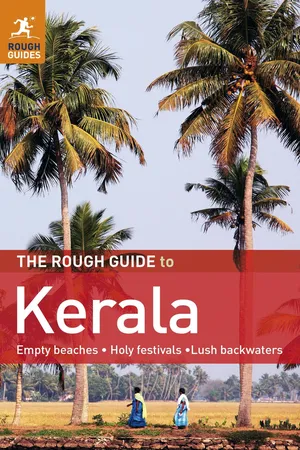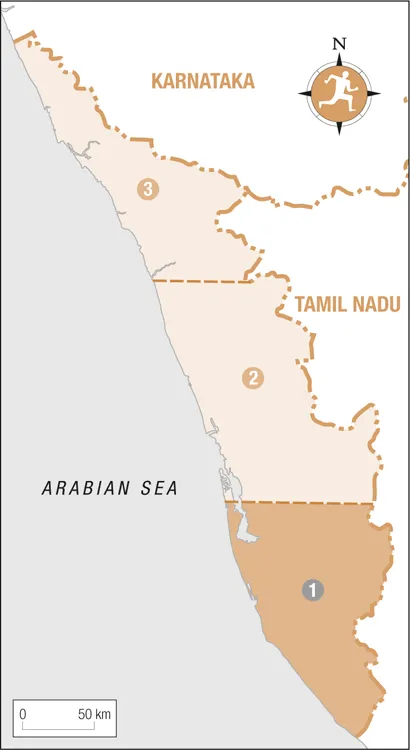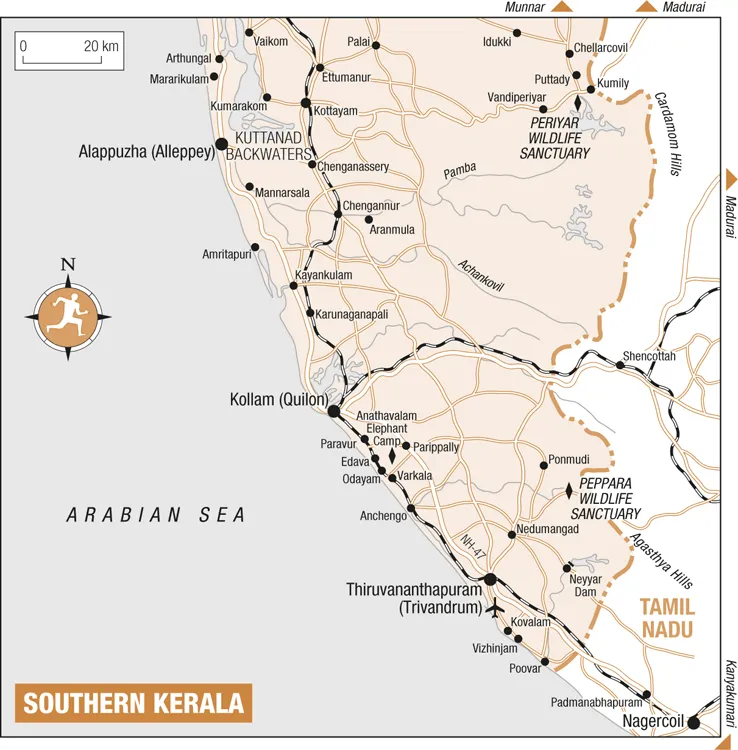![]()
Explore Kerala
Southern Kerala – Part 1 >
Southern Kerala – Part 2 >
Central Kerala >
Northern Kerala >
![]()
Southern Kerala – Part 1
Kerala's intensely tropical south, stretching from the Tamil Nadu border to the Kuttanad backwaters, was formerly the heartland of the princely state of Travancore, the region's chief power in the eighteenth century. It was the Travancore rajas who, under sponsorship from the British East India Company, first developed Thiruvananthapuram as a capital, and whose patronage of education and the arts did much to shape Kerala's contemporary identity.
Traditional arts continue to thrive in the modern city, with two of south India's major music events – Nishagandi (mid-Jan) and the Swathi Sangeetotsavam (Oct/Nov) – staged in its open-air theatres each year, alongside regular performances of kathakali and kudiyattam. Thiruvananthapuram's principal sight, however, is indisputably the Sri Padmanabhaswamy temple, whose mighty gateway tower and red-tiled rooftops are reflected to superb effect in the waters of the adjacent bathing tank. The road leading to it, passing the royal palace of Puttan Malika, also serves as the venue for the city's largest festivals: Arattu (held biannually in March/April and Oct/Nov), and the harvest celebration of Onam (late Aug/Sept).
The arcane world of Keralan temple festivities couldn't be further removed from the holiday culture prevailing at nearby Kovalam, barely half-an-hour's drive south of the capital. The resort's quartet of sandy bays, interrupted by brown boulder headlands dotted with coconut trees, was where beach tourism in general, and the whole concept of ayurveda-based holidays in particular, first took root in Kerala. Foreign backpackers started coming here in serious numbers back in the early 1980s, staying in palm-leaf huts on the outskirts of the fishing village, but since then a low-rise concrete jungle has engulfed the groves behind the grandest of Kovalam's four bays, Lighthouse Beach – frequented by an incongruous mix of European ayurveda tourists and somewhat less healthy British sun-worshippers.
Once you are clear of neighbouring Vizhinjam, the area's busiest fishing harbour, you'll find idyllic sandy beaches fringing the entire coastline extending south from Kovalam. Backed by a lush curtain of coconut plantations, this stretch of coast is where you'll find the far south's most sophisticated spas, five-stars and boutique hideaways, nestling above hidden coves and amid the dense canopy of palm trees. The locals, however, still derive most of their income from coconut and rice cultivation, along with inshore fishing – the early-morning polyphonic songs of men hauling long handnets from the surf remain one of the area's defining features.
Aside from Thiruvananthapuram's museums, bazaars and great-value restaurants, possible targets for forays inland from Kovalam include the splendid former royal palace at Padmanabhapuram, an hour or so south. Another fine specimen of traditional Keralan architecture, Koikkal Kottaram, stands just outside the capital at Nedumangad, which can easily be slotted in to a trip to the Agasthya Hills, 25km northeast. The hub of this beautiful hill region, and only an hour's drive away from the coast, is the lakeside settlement of Neyyar Dam, where Kerala's most popular yoga ashram, the Sivananda Yoga Vedanta Dhanwantari, attracts devotees from all over the world. With a couple of days to spare, you could press on deeper into the mountains to overnight at the hill resort of Ponmudi, set amid fragrant tea and cardamom plantations at an altitude of just over 1000m, or go for treks and jeep trips in the forests straddling the Tamil border.
North of Thiruvananthapuram, the Hindu pilgrimage village and tourist resort of Varkala, with its spectacular beach, is an essential stop on the well-trodden trail between the far south of the state and Kerala's famous backwaters region, Kuttanad. The gateway to this watery world, best explored on an old-style kettu vallam rice barge, is the market town of Kollam (Quilon) – a former dynastic capital and port. Heading north from there you might want to pause at Amritapuri for a hug from Kerala's world-renowned guru, Amma. Her ashram, a baby-pink pile of multistorey concrete towers, is one among several unique sights reachable from the backwaters' main hub, Alappuzha. Others include a Tantric snake-worship temple at Mannarsala, and the beautiful royal palaces at Kayamkulam.
A maze of canals and rivers unfolds from the southeast edge of Alappuzha – epicentre of the area's rice boat cruise scene. Because the boat operators tend to moor overnight on secluded riverbanks, few of their clients actually set foot on the myriad islands making up this fascinating micro-region, but the villages hold plenty of guesthouses and homestays – many of them in traditional gabled waterfront houses where you can watch the world sail by from the comfort of a traditional pillared veranda.
Alappuzha also serves as the springboard for trips on to exquisite Vembanad Lake, the vast, shimmering lagoon to the north. You may not be able to make them out in the heat haze, but the lakeshore is dotted with luxury resort complexes, the main concentration of them around the Kumarakom Bird Sanctuary on Vembanad's eastern flank.
Unless you reach it by boat, access to Kumarakom tends to be via the town of Kottayam, capital of a prosperous rubber-growing region dominated by Kerala's wealthy Syrian-Christian community. Beyond a couple of ancient churches dating from the earliest days of Christianity in India, it offers little to detain travellers, although devotees of Arundhati Roy's The God of Small Things may wish to make a pilgrimage to the author's home village of Aymenem, on the outskirts of town, which inspired the novel's setting.
Kottayam also serves as a convenient pit stop on the long haul east from the coastal belt into the Western Ghat range. Chief among the attractions of the so-called "Cardamom Hills" is the Periyar Wildlife Sanctuary, a former royal hunting reserve whose impressive rainforest is centred on a reservoir where wild elephant and other animals still congregate. Safaris are conducted either on noisy diesel launches (which tend to scare any wildlife within earshot away) or on paddle-powered bamboo rafts – part of a groundbreaking eco-tourism initiative introduced by the local forest department.
Highlights >
Some history >
Thiruvananthapuram (Trivandrum) >
Kovalam >
North of Kovalam >
South of Kovalam >
Padmanabhapuram Palace >
North of Thiruvananthapuram >
Varkala and around >
South of Varkala: Anchengo Fort >
Highlights
Thiruvananthapuram With its huge temple, royal palace, museums and traditional Keralan restaurants, the state capital makes an interesting day-trip from the nearby resorts.
Lighthouse Beach, Kovalam The nerve centre of Kerala's busiest resort, where handnet fishermen rub shoulders with sunseekers from northern Europe.
Padmanabhapuram Palace This elegant royal palace, an hour's drive south of Kovalam, is the finest specimen of regional architecture in south India.
Varkala Chill out in a cliff-top café, sunbathe on the beach or soak up the atmosphere around the town's busy temple tank.
The backwaters Explore the beautiful waterways of Kerala's densely populated Kuttanad region on a rice barge or punted canoe.
Vembanad Lake Kerala's largest lagoon is ringed by resorts and atmospheric homestays.
The Ettumanur murals Among the few examples of this ancient temple art form viewable by non-Hindus – and very fine ones at that, featuring a recumbent Vishnu depicted in swirling, earthy colours.
Bamboo rafting, Periyar The best way to sidestep the crowds and get close to the wild elephants, bison and even rare tigers lurking in the jungles of Kerala's most visited wildlife sanctuary.
< Back to Southern Kerala – Part 1
Some history
Travancore was the last in a long line of princely states stretching back to the second century BC, when the Ay dynasty were the dominant political power in the far southwest of India. For centuries, the Ays formed a buffer between the mighty Pandyan dynasty to the east, which ruled most of what is now Tamil country, and the Cheras to the north, whose gradual imperial expansion began in the first centuries of the Christian era, from their capital, the port city of Muziris (near modern-day Kochi).
Chera power was eroded by constant attacks from the south by the Pandyans and, after them, the powerful Cholas, but revived around 800 AD under an illustrious line of kings who would become known as the Kulasekharas. Under their enlightened rule, during the so-called Second Chera Empire, southern Kerala enjoyed three centuries of stability and prosperity. This was the region's classical golden age, when literature, the arts and commerce thrived, and when Malayalam began to take shape as a language distinct from Tamil. The capital, Mahodayapuram, grew famous all over the ancient world as a centre of learning and culture, boasting south India's only observatory.
However, in 999 AD, the region plunged into a century of tumult as war once again erupted with the Chola empire. Foreign trade declined, temples were neglected, centres of learning were converted into military academies, the capital was burned to the ground and the second Chera empire slowly began dissolving into smaller chiefdoms.
With the demise of the Kulasekharas, Venad, one of their former principalities, emerged as the most important swaroopam, or kingdom, in the south. On the back of brisk trade with China and Persia, Quilon (modern Kollam), its main port, became a glittering city of many temples and paved roads, described in glowing terms by Marco Polo. Over the coming four centuries, however, the rise of other regional dynasties gradually nibbled away at Venad's territory, pegging its kings back into a narrow belt between Thiruvananthapuram and the tip of India.
The modern history of Travancore as southern Kerala's major power begins with the accession in 1729 of Raja Marthanda Varma. By this time, what remained of Venad – now better known as "Thiruvitamkode" (later corrupted to Travancore) – was in rough shape: the priestly caste, in cahoots with the local nobility, controlled the workings of state; trade and taxation were dominated by competing European powers and the king's coffers were empty.
With support from, among others, the British East India Company, Marthanda Varma set about his policy of "blood and iron", crushing the power of the region's feudal lords and extending his territory northwards. In 1741, his campaign culminated in the dramatic defeat of the Dutch East India Company at the Battle of Colachen – the first time an Asian army succeeded in vanquishing a European power in open combat. Thereafter, Travancore controlled the local pepper trade, profits from which financed the move from the rajas' magnificent palace at Padmanabhapuram (now just across the Kerala– Tamil Nadu border) to the new capital at Thiruvananthapuram.
An invasion by Tipu Sultan, the legendary "Tiger of Mysore", was held at bay in the late eighteenth century, but only with more support from the British, an arrangement that ultimately led to Travancore becoming a Protectorate of the East India Company, with its own Resident and nineteen-gun salute. The peace dividend of Pax Britannica, however, enabled Travancore's rulers to fund the development of roads, schools, colleges, hospitals and artistic life in the region, whose population became one of the best educated in India. This widespread literacy is often regarded as having paved the way for...


